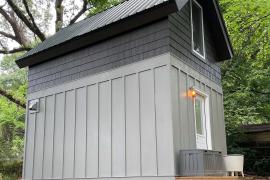It’s Friday afternoon at the Belle Isle Summer Nature Camp, a day camp in Detroit, Michigan. As parents and younger siblings mill around the auditorium, a happy murmur of conversation is heard as campers proudly display the work they’ve done over the week of summer camp. Students show off the ceramic tiles they created earlier that week, now glazed and fired. Student journals, drawings, and other art cover the tables. One group of campers plays a video they created encouraging people to plant milkweed and native flowers for monarch butterflies. Another student reads aloud from a story about the animals she encountered during camp. Three boys come up and perform a rap that includes possibly every single animal they saw during their week at camp.
These students are presenting work they did as part of the project-based learning (PBL) component of Belle Isle’s summer camp, a way to empower students to direct their own learning. We have incorporated project-based learning into the arc of our summer camp and have been thrilled by the results.
Project-based learning empowers students to seize control over their camp experiences, following their interests and passions as they address a driving question. As students work with one another to create projects to share, they become responsible for the assessment of their work. Project-based learning frees students from the anxiety of meeting the expectations of school while allowing them the agency to create using the meaning they’ve developed from their experiences. This is a powerful reimagination of what is possible within camp, and one that camp professionals should consider.
Project-based learning units share a set of defining characteristics. As described by Larmer, Mergendoller, and Boss (2015), PBL units feature a driving question or challenge; thorough investigation and inquiry; authentic problems that require a solution; student voice and choice; reflection; revision; and finally, a project to be shared and celebrated. PBL in a summer setting need not possess all these features ― a shorter unit may include less time for inquiry or revision, for example. While classroom PBL units are built upon real-world challenges and problems, camp-based project-based learning can choose to address imaginative and fantastic problems, infused with the magic of camp, as their foundation.
Case Study
The Belle Isle Summer Nature Camp is an excellent case study for project-based learning in a summer camp setting: many of the defining features of project-based learning can be found in the PBL framework instructors use with the camp’s older students, ages 8 to 12. In this curriculum, campers are challenged to consider their experiences over the entire week and to create a product to be shared answering the question “What should visitors to Belle Isle know about the living things found there?” Campers spend their week of camp becoming experts on the living things on Belle Isle and then are charged with sharing their expertise. This is the driving question or central challenge of the project.
| Belle Isle Summer Nature Camp, a program of the Detroit Zoological Society, is a free day camp for low-income students primarily living in the Detroit, Michigan, area. It serves campers aged 5 to 12 in a variety of nature explora-tion and immersion, nature play, environmental education, and project-based learning topics. |
A great deal of student choice is involved in this project. Students choose whom to work with, what they present, and, most importantly, how they present their projects. Students can build landscapes, create posters, perform skits, make videos, write stories, etc. In expressing their work through a medium that has meaning for them, they engage with the material in a way they may not have otherwise.
The final projects and the celebration accompanying them, as described in the introduction, are central to the success of the PBL portion of our camp experience. Campers use a wide variety of modes of expression in their projects, while also focusing on quite different content depending on their interests. Some students choose to focus on invasive species found on the island, while others create posters listing ways adults could help safeguard nature. Students are inspired to raise awareness of the conservation efforts supporting local species or to artistically share a series of little-known facts about animals found in the area. Campers’ final projects are a concrete representation of how Belle Isle and their camp experience have spoken to them.
Why Project-Based Learning at Your Summer Camp?
Camp is a place unlike any other — where students grow into themselves, where they make sense of the world and find their place in it, challenge themselves socially, and learn to succeed and to fail. Project-based learning is a strategy for engaging young people in academic, personal, and social growth that supports all these goals.
Content or Objective Outcomes
Project-based learning is a flexible model for camper engagement that can support a wide variety of camp goals. The driving question for our nature-based camp was about the natural world campers had been investigating. Our question and the resulting projects could just as easily be an engineering challenge, as in science, technology, engineering, and math (STEM) or robotics camps.
Project-based learning can also fully embrace the magic and silliness of summer camp. Whimsy, storytelling, and fanciful parts of camp can find a home in a driving question. The younger campers in the Belle Isle Summer Nature Camp investigated the decidedly nonacademic driving question “Is Belle Isle a good place for Gnomeo, the Gnome, and his gnome family to make a home?” Camp Wildfolk, a West Hollywood day camp, engages campers in projects on a variety of distinctly camp themes, including a session where each group of campers is responsible for illustrating a different decade of the 20th century. The Wildfolk unit concluded with the staff running an obstacle course inspired by the Nickelodeon-inspired 1990s, featuring copious amounts of slime (Young, 2017).
Social and Success Outcomes
Social and personal development is a significant part of the fabric of summer camp. Students find out who they are in a place completely outside of their home and school, developing relationships that could not have occurred anywhere else. Project-based learning supports these kinds of discoveries and bonds. By encouraging campers to work in groups on their projects, they have the chance to create new bonds or deepen existing ones. More significantly, campers who may have struggled in traditional academic settings now find themselves in charge of setting the standard for their own success. Project-based learning in summer camps is a low-stakes way to cultivate a positive sense of self-efficacy ― that is, a sense that one has the skills to be successful and one’s accomplishments are limited only by effort expended (Gutman & Schoon, 2013).
Incorporating Project-Based Learning into a Camp Structure
Despite its origins in the classroom, project-based learning is an excellent fit for the summer camp environment. Camps are free from the assessment requirements of the classroom and can choose to discard any part of the project creation process that doesn’t fit with camp goals or within the camp time frame. That said, incorporating project-based learning into an existing summer camp can be a challenging proposition.
We found that campers weren’t accustomed to the structural freedom of project-based learning. Part of that was likely that they didn’t get much choice in the classroom setting during the school year, and part may be that our guiding question was too broad for the time we had. As the summer progressed, our camp staff found ways to make the project brainstorming portion easier. After priming campers by generating a list of animals and experiences seen and had on the island, counselors created a menu of possible project ideas: create a book, poster, skit, advertisement, or other. This menu approach reduced the anxiety of choosing a project idea and streamlined the project creation process, both valuable outcomes.
Based on our experiences, here are some recommendations for implementing a new project-based learning component into your summer camp:
- Cultivate your driving question. Aim for a driving question that is intriguing, fun, and open-ended enough to allow for a variety of possible projects. Try to match your question to the spirit and culture of your camp.
- Decide how much time you want to devote to your project. While a week-long project can yield impressive results, students can get a lot out of a focused brief unit, even as short as an afternoon.
- Prepare your staff. Anticipate some objections and resistance. Share the benefits of project-based learning and why you think it will enhance your camp. Do a project as a part of staff training, talk through the process, and listen to concerns.
Keep the big picture in mind. The most important thing in the project-based learning journey ― as with all of camp ― is that campers and staff have a fun and memorable time and learn valuable life lessons along the way. Provide extra support to your staff as they adjust to a new role as project facilitators.
A Celebration
Parents and siblings sit in a wide semicircle inside the auditorium. Conversations cease as the nature camp staff begin our celebration by recounting the hikes, field trips, and projects campers experienced over the course of the week. Campers beam as they are called up to receive their diplomas from their completion of a week of island exploration. After exploring and experiencing the variety of life found on the island, campers have met the challenge of synthesizing those experiences with their personal passions and created meaningful projects they shared with the camp community.
Project-based learning has a great deal to offer summer camp programs. The structure supports many of the personal and social growth goals of camp. Further, there are very real self-efficacy gains from giving campers the power to assess their own success. Perhaps most importantly, the reflection on and concrete expression of their experience makes the effects of camp last far beyond their session. Project-based learning is a powerful tool for ensuring that campers get the richest camp experience possible. It is a reimagination of camp that warrants consideration.
References
Gutman, L. M., and Schoon, I. (2013). The impact of non-cognitive skills on outcomes for young people. Education Endowment Foundation. Retrieved from educationendowmentfoundation.org.uk/public/files/Publications/EEF_Lit_Review_Non-CognitiveSkills.pdf
Larmer, J., Mergendoller, J., & Boss, S. (2015). Setting the standard for project based learning: A proven approach to rigorous classroom instruction. Alexandria, VA: ASCD.
Luke Grange works as an education specialist at the Belle Isle Nature Center for the Detroit Zoological Society in Detroit, Michigan. He currently is the director of Belle Isle Summer Nature Camp and has worked in the past at YWCA Camp Westwind, YMCA Camp Seymour, Camp Namanu, and various residential environmental education programs. He completed this project as a part of his graduate work with Project Dragonfly at Miami University in Oxford, Ohio. Please direct any correspondence to [email protected].


